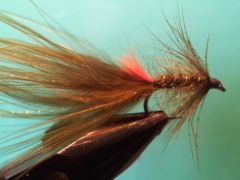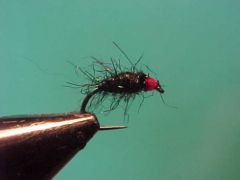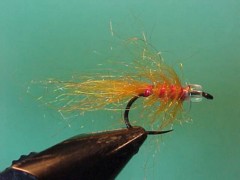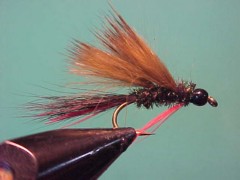Posts Tagged ‘flies’
{{start}}
{{end}}
{{+1}}Calendar – Central Qld species{{-1}}
{{start}}
{{end}}

{{+1}}Mark II woolly bugger – alternate tie{{-1}}
{{start}}
The MK 2 woolly buggers evolved from standard black and olive woolly buggers as a fly that would imitate an American frog that had bright red between its hind legs and consequently the red tag is traditionally tied in below the tail. This tie is a little more popular than the original tie these days and is main point of difference is that the tag tied in on top.{{end}}

{{+1}}Snail – Jim’s Eucumbene version{{-1}}
{{start}}
Snails are a food source for trout throughout the year. Having said that they are often overlooked by fly fishers. In colours imitating the naturals in the area to be fished they can be slowly twitched along the bottom or the weed beds with great results. They are also a good ambush fly for trout foraging the margins.{{end}}

{{+1}}Yabby /crayfish{{-1}}
{{start}}
This is my latest addition to the genre and it's more of a polaroiding fly than a stripping fly. I like to use it to ambush sighted fish by casting well in front of patrolling fish and generally a little closer to shore and then let the fly sink and lie doggo.{{end}}

{{+1}}Zug bug – Chatto’s version{{-1}}
{{start}}
This fly has stood the test of time being designed in the 1930's as a cased caddis imitation in the Catskills by Cliff Zug. It continues to be relevant today on any water where caddis are on the menu. It is equally at home in rivers and lakes. It's no surprise that the body is peacock herl a material that has made flies like the diawl back and prince nymph amongst the top fish taking flies.{{end}}

{{+1}}Zug bug jig – Chatto’s version{{-1}}
{{start}}
This fly has stood the test of time being designed in the 1930?s as a cased caddis imitation in the Catskills by Cliff Zug. This jig version is particularly good for running water as the shape of the jig hook causes the leader to partially invert the fly mitigating snags as the fly bounces along the bottom.{{end}}

{{+1}}Rat faced McDougal{{-1}}
{{start}}
This appears to be an American fly designed by Harry and Elsie Darby (or Darbee), the famous fly tiers of Roscoe, New York. The story goes that a friend of theirs, and several names have been put forward including Percy Jennings, an amateur fly tier from Cold Spring Harbour and Carl Otto von Kienbush a well known New York angle asked them to design a highly visible and buoyant dry fly.{{end}}

{{+1}}BMS 2{{-1}}
{{start}}
The BMS is a favourite fly at Lake Bullen Merri where it gets its name BM Special. Because of its history of success it is often regarded as a quintessential Rainbow trout fly by many Victorian fly fishers. This variant is tied with round tinsel which doubles up as a dubbing loop. In smaller sizes it has also proven itself as a great attractor fly for brown trout.{{end}}

{{+1}}Bead head bag fly{{-1}}
{{start}}
I now tie it in three versions. The first is as set out in the recipe below. Originally designed for red fin feeders it has become my favourite bag fly overall. It has red hackle fibres tied under the tail and as a light beard and over time I found these a great trigger point for all versions. The second version is all brown except for the red beard and is a great alternative to a Diawl Back. Finally I tie a bead head version for when I want to fish a little deeper.{{end}}

{{+1}}Claret hopper{{-1}}
{{start}}
A popular fly in the United Kingdom this fly is equally at home early and late in the season in Australia. We don't have any burgundy coloured hoppers that I am aware of but this buggy looking fly often works when the first and last of the seasons terrestrials are around. Whilst not a strong floater this fly ticks all the boxes for those that want an enticing fly that will sit in the surface film.{{end}}













